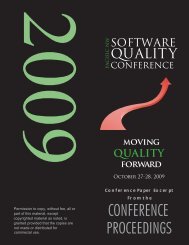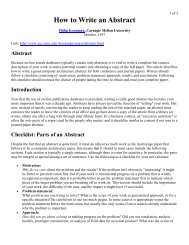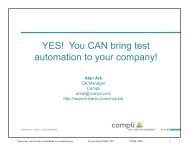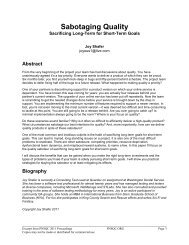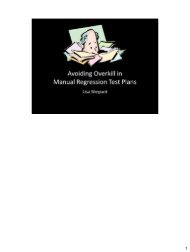Permission to copy, without fee, all or part of this material ... - PNSQC
Permission to copy, without fee, all or part of this material ... - PNSQC
Permission to copy, without fee, all or part of this material ... - PNSQC
Create successful ePaper yourself
Turn your PDF publications into a flip-book with our unique Google optimized e-Paper software.
strength <strong>to</strong> C is just 6). On the other hand, option A is not a Schulze winner because option A's path<br />
strength is better than option B (8 <strong>to</strong> 6) but option A's strength is w<strong>or</strong>se than option C (6 <strong>to</strong> 7). Figure 2<br />
shows the matrix <strong>of</strong> path strengths that c<strong>or</strong>responds <strong>to</strong> the data in Figure 1 and demonstrates that option<br />
C is a Schulze method winner. Visu<strong>all</strong>y, an option is a Schulze winner if every path strength value on that<br />
option's row is greater than <strong>or</strong> equal <strong>to</strong> the c<strong>or</strong>responding value across the matrix's main diagonal.<br />
<br />
Although the Schulze method can be easily perf<strong>or</strong>med by hand, the process can be err<strong>or</strong>-prone.<br />
Theref<strong>or</strong>e, in practice the Schulze method is usu<strong>all</strong>y perf<strong>or</strong>med using a s<strong>of</strong>tware <strong>to</strong>ol. The Schulze<br />
method has strengths and weaknesses. One weakness <strong>of</strong> the Schulze method in some scenarios is that<br />
Schulze is not immediately intuitive. In situations where the evalua<strong>to</strong>rs are stakeholders, the Schulze<br />
method can possibly be viewed as a black box technique that produces a magic result. The primary<br />
advantage <strong>of</strong> the Schulze method is that is has been extensively analyzed and has been shown <strong>to</strong> meet<br />
many fav<strong>or</strong>able criteria. Rec<strong>all</strong> that the B<strong>or</strong>da count system can sometimes be affected by the removal <strong>of</strong><br />
an irrelevant alternative. There are many voting system criteria. F<strong>or</strong> example the mono<strong>to</strong>nicity criterion<br />
can be loosely stated as the principle that a winning option cannot become a non-winner by one <strong>or</strong> m<strong>or</strong>e<br />
evalua<strong>to</strong>rs ranking that option higher. There are many proposed voting system criteria, and the Schulze<br />
method has been shown <strong>to</strong> meet most <strong>of</strong> these criteria. An interesting exception is that the Schulze<br />
method violates what is c<strong>all</strong>ed the <strong>part</strong>icipation criterion. In inf<strong>or</strong>mal terms, it is possible <strong>to</strong> add <strong>to</strong> an<br />
existing system, new voters who prefer the current winner <strong>to</strong> some other alternative, which results in the<br />
less preferred alternative becoming a Schulze winner. In spite <strong>of</strong> its sh<strong>or</strong>tcomings, based on my<br />
experience, the Schulze method is <strong>of</strong>ten very effective, especi<strong>all</strong>y in situations with a large, educated<br />
group <strong>of</strong> evalua<strong>to</strong>rs (meaning they have knowledge <strong>of</strong> the underlying Schulze method and theref<strong>or</strong>e do<br />
not view the alg<strong>or</strong>ithm as mysterious) who are determining a policy alternative (as opposed <strong>to</strong> a product<br />
decision) and who are stakeholders in the final result. F<strong>or</strong> example, the Schulze method is used by<br />
several Open Source groups <strong>to</strong> determine general policy decisions and <strong>to</strong> elect <strong>of</strong>ficers. In s<strong>of</strong>tware<br />
development and quality scenarios, the Schulze method is gener<strong>all</strong>y an excellent technique <strong>to</strong> employ.<br />
== Conclusions<br />
When perf<strong>or</strong>ming a collab<strong>or</strong>ative determination <strong>of</strong> a best alternative, the interpretation <strong>of</strong> exactly what<br />
best alternative means is entirely defined by the approach used. Each technique has pros and cons and<br />
there is no single best approach in <strong>all</strong> situations. Some <strong>of</strong> the key fac<strong>to</strong>rs you should consider when using<br />
collab<strong>or</strong>ative evaluation techniques include the number <strong>of</strong> alternatives, the number <strong>of</strong> evalua<strong>to</strong>rs, whether<br />
the alternatives are policy decisions <strong>or</strong> product decisions, and the extent <strong>to</strong> which evalua<strong>to</strong>rs are affected<br />
Excerpt from 2008 Proceedings<br />
<strong>PNSQC</strong>.ORG<br />
Page 7 <strong>of</strong> 8







